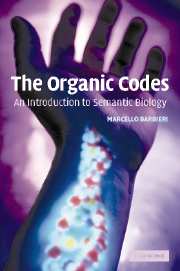Book contents
- Frontmatter
- Contents
- Foreword
- Dedication
- Acknowledgements
- Introduction
- Chapter 1 The microscope and the cell
- Chapter 2 Theories of evolution
- Chapter 3 A new model for biology
- Chapter 4 Organic codes and organic memories
- Chapter 5 The origin of life
- Chapter 6 Prokaryotes and eukaryotes
- Chapter 7 The Cambrian explosion
- Chapter 8 Semantic biology
- Chapter 9 A brief summary
- Appendix: Definitions of life
- Afterword
- References
- Index
Chapter 1 - The microscope and the cell
Published online by Cambridge University Press: 23 November 2009
- Frontmatter
- Contents
- Foreword
- Dedication
- Acknowledgements
- Introduction
- Chapter 1 The microscope and the cell
- Chapter 2 Theories of evolution
- Chapter 3 A new model for biology
- Chapter 4 Organic codes and organic memories
- Chapter 5 The origin of life
- Chapter 6 Prokaryotes and eukaryotes
- Chapter 7 The Cambrian explosion
- Chapter 8 Semantic biology
- Chapter 9 A brief summary
- Appendix: Definitions of life
- Afterword
- References
- Index
Summary
The cell theory and the theory of evolution are the two pillars of modern biology, but only the latter seems to be the object of ongoing research and debates. The cell theory is generally regarded as a closed chapter, a glorious but settled issue in the history of science. The emphasis today is on cell experiments, not on cell theory, and there is no doubt that one of our greatest challenges is the experimental unravelling of the extraordinary complexity that has turned out to exist in the cellular world. At various stages of this book, however, we will see that the experimental results suggest new ideas, and at the end of the book it will be possible to combine them in a new model of the cell. This is because cells are not only what we see in a biological specimen through the lenses of a microscope, but also what we see through the lenses of a theory. The cell, after all, is a system, and understanding the logic of a system requires some theorising about it. And since this theorising has a long history behind it, let us begin by retracing the main steps of that intellectual journey. This chapter shows that the concept of the cell had to be imposed on us by the microscope because it was unthinkable in the world-view of classic philosophy. And after that intrusion, the concept has gradually changed and in so doing it has changed our entire approach to the problems of generation and embryonic development.
- Type
- Chapter
- Information
- The Organic CodesAn Introduction to Semantic Biology, pp. 9 - 32Publisher: Cambridge University PressPrint publication year: 2002



